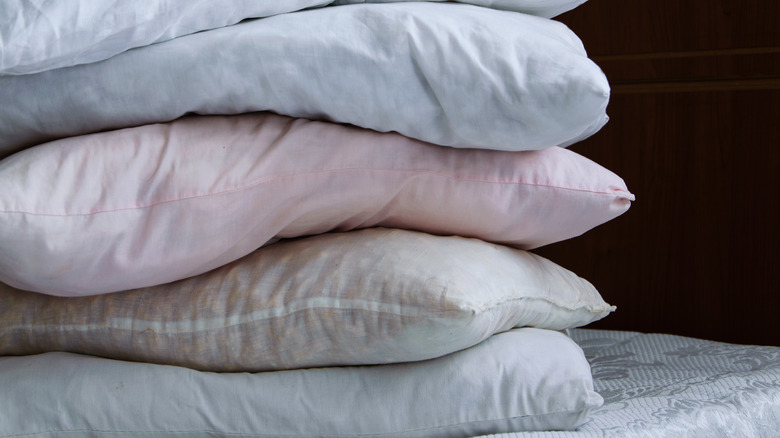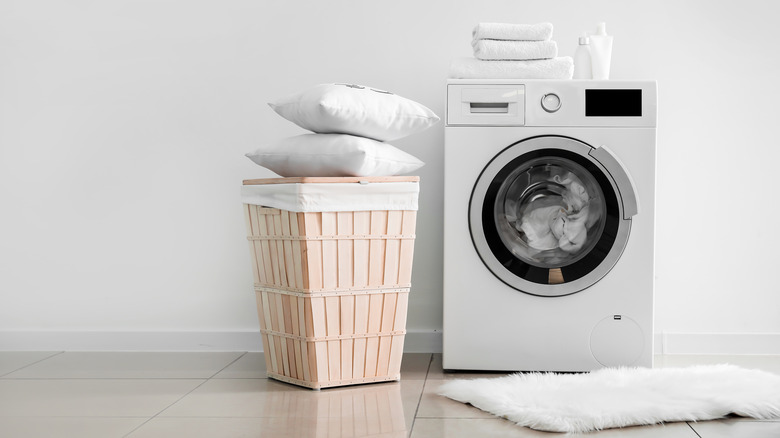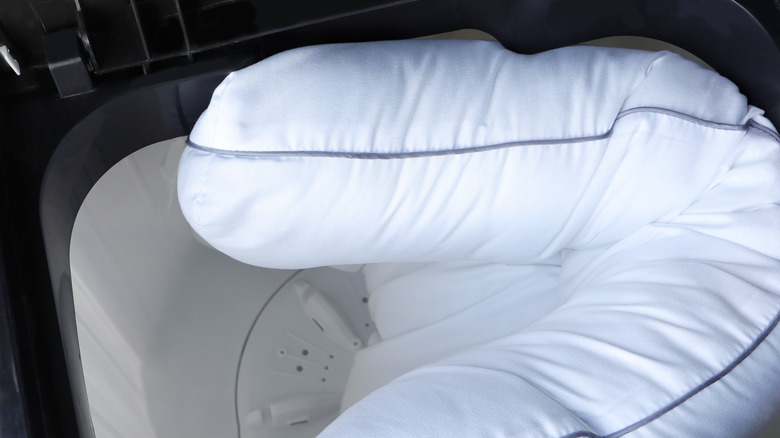Skip The Soaking Mess & Strip Your Bed Pillows The Easy Way
If you're on the cleaning side of TikTok, you might already be familiar with the viral laundry stripping hack. This extremely popular cleaning trend aims to pull out sweat, oils, and other residue using borax, baking soda, and laundry detergent in your bathtub. Countless posts on the video-sharing app appear when you search "laundry stripping," all of which show murky bathtubs following a good strip wash of pillows, work clothes, bedding sets, or thrift store clothing hauls. Though the washing technique seems to be quite effective, most people can't make the time to commit to the days-long practice. Instead, we can get better and quicker results when we adapt the idea to work in our washing machines.
Pillows, like your sheets, blankets, and comforters, need to be washed every once in a while to clean them of sweat, dirt, and grime. They don't need to be run as often as your bedding and pillowcases, but keeping the pillows themselves clean helps to reduce allergy flare-ups, skin breakouts, and more (per Sleep Foundation). Depending on what kind of pillows you own, they will need slightly different cleaning routines to keep them in good shape. Memory foam, gel, down feather, and cotton pillows should all come with general instructions and warnings for cleaning. Be sure to check their label beforehand to know what washing methods to avoid.
How to strip your pillows inside of a washing machine
To steer clear of the mess that stripping laundry in a bathtub will cause, you can treat your washing machine as a soaking vessel for the same results. This way, you can still use your tub without filling it with nasty oils left over from grimy pillow stripping, and your laundry will still be cleaner than before. The big difference you'll notice between stripping your bed pillows in a bathtub vs. a washing machine is that you'll miss gagging over the soiled water left behind. You might only use your bathtub instead if your pillows are much too soiled. However, in this case, we'd recommend replacing them. Even with good care, all pillows have a limited lifespan. Most experts, including the Asthma and Allergy Foundation of America, insist that you exchange your pillows once every two years.
When stripping pillows correctly, you'll need to use a top-loading washing machine. Front loaders can still get the job done when run as a rinse-and-spin load, but top loaders allow you to soak before rinsing and draining. First, set yours to fill with hot water and add the stripping ingredients: 1/4 cup borax, 1/4 cup washing soda, and 1/2 cup powdered detergent. Then, add your pillows and let them soak for a minimum of four hours. Finally, drain it, set the machine to rinse and spin, and add an extra rinse for good measure.
Keep your pillows cleaner
Once your bed pillows have been washed of the residue that's built up on them over the years, you'll want to try to keep them that way by taking some preventative measures. Usually, the reason that laundry becomes so grimy is that you are using an excessive amount of laundry detergent or fabric softener. This, coupled with an ineffective rinse cycle or an overstuffed washing machine, leads to build-up on your bedding or clothes that makes them feel or look unclean.
When it comes to pillows, however, the build-up is often caused by sweat, body oils, and spills. The easiest way to keep yours clean is to use pillow protectors and pillowcases which are much easier to wash regularly. As we already mentioned, make sure to wash your pillow coverings with minimal detergent and little to no fabric softener, and don't forget to add an extra rinse cycle to keep your bedding free of gross residue.


